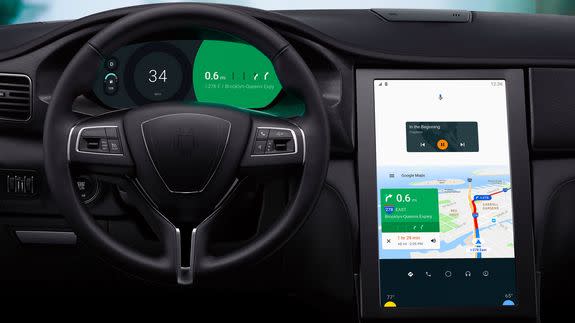Android N will run natively in cars

Google is setting up Android to take over cars.
The upcoming Android N release will allow Android to run natively within cars, letting Google put much deeper hooks into the cars it runs on, the company announced Wednesday at its I/O developer conference.
SEE ALSO: Android Auto puts Google Maps where they belong: Right in your dash
In addition to media, navigation and messaging apps that you can currently control from Android Auto-equipped dashboards, native integration also allows drivers to access their heating and air conditioning, AM/FM radio and other core functions.
It also means that carmakers can incorporate Android directly into instrument clusters. One concept Google showed off, for example, puts a Google Maps navigation widget in the instrument cluster, right next to the car's speedometer. The concept, on a Maserati Ghibli, is also equipped with a 15-inch 4K display and a 720P digital cluster.

Image: Google
Another advantage to the system is that it stands to make in-car app support much more ubiquitous, since Android also brings its ecosystem of developers.
"As they move away from using proprietary systems for infotainment, a big win for them [car manufacturers] is going to be that the ecosystem that’s part of Android will come with that so they don’t have to think about, 'How do I go out and make developers write for this proprietary system?'" Mickey Kataria, director of product management for Android Auto, tells Mashable.
Of course, it will still be up to individual car companies to decide whether or not to adopt Android, and they will have a lot of flexibility in deciding exactly how they implement it into their vehicles. Even then, we won't be seeing Android N running natively on anything more than a concept anytime soon. The earliest we could see an integration hit the road would be 2017, Kataria says.

But Google isn't focusing all its efforts on newer cars. Google also plans to untether Android Auto from the dashboard with an updated Android Auto app that can work independently of infotainment systems. This means even people with older cars will be able to take advantage of the Android Auto interface.
The standalone app, which will be available later this year, is optimized to be used while driving. It puts maps front and center — with the same Google Now cards you'll find in Android Auto on the dashboard — and features apps with larger buttons and text to make them easier to navigate while on the road.

Image: Google
Those who already have Android Auto-compatible infotainment systems are also getting a few upgrades, expected to roll out later this year.
Updates include support for Waze (the most-requested Android Auto feature, according to Google) and hands-free voice commands (activated by, what else, "OK Google.") Finally, Android Auto will be going wireless — with a catch. Cars that have both Android Auto and Wi-Fi support, will be able to connect to Android Auto.

 Yahoo News
Yahoo News 